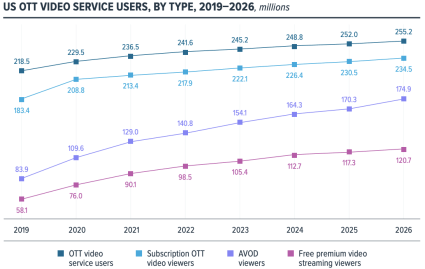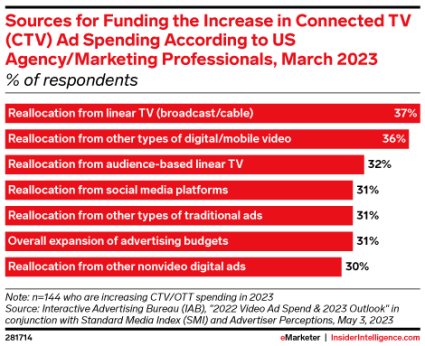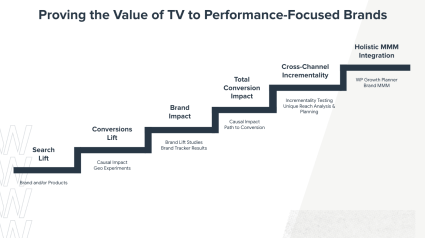To state the blindingly obvious: the television advertising landscape has changed rapidly over the last few years. But even as we’ve watched TV go from a traditional linear model to the increasingly fragmented streaming ecosystem, many brands are still trying to use the same old media metrics that worked in the era of channel-surfing and cable.
Old-school methods can still effectively measure delivery and reach, but that’s not enough in today’s competitive, addressable TV environment, especially as ads get more expensive and accountability in ad spend becomes increasingly mission-critical. To make the case for those dollars and maximize the impact of linear and connected TV (CTV) advertising, you’ll need to do better than that.
It’s time to reevaluate your data strategy and connect those activations to real business outcomes.
Why traditional media metrics don’t go the distance in today’s video landscape
The days of purchasing traditional TV ads upfront and getting logs back afterward are long gone; post-log feedback is too slow for marketers who need to make meaningful shifts to the buying approach in a viewing environment dominated by streaming. Even worse, it doesn’t do anything when it comes to proving the value of these campaigns to the business.
The explosion of consumer viewing options, from subscription services to AVOD, means advertisers have more control over inventory access and ad placement than ever, but they’ve also resulted in data silos that make real-time campaign optimizations a challenge.
Even as more streaming services shift to ad-supported models, consumers have still turned to ad-free CTV and TV viewing more often; those viewing options have actually increased their share of the user pie to 22% in 2023, up from 17% in 2022, according to Wieser. Despite more options, less inventory is available to advertisers. The inevitable truth is that your brand needs to be more strategic and data-focused in your investments to increase reach.

Source: eMarketer
OTT isn’t the only option; even linear TV advertising is becoming more flexible. Brands are opting to buy direct response remnant inventory or test new-to-market programmatic options that blur the lines between traditional upfront TV buying methods and more modern strategies. Across the board, TV and video advertising is only getting more performance-focused.
Per IAB, a big chunk of marketers are looking to pull budget from other parts of the media plan to increase CTV investment, but you can’t make that case without forging the necessary connections between media metrics and core business outcomes so internal stakeholders (like your finance team) can understand and quantify the expected impact.

- Source: eMarketer
That can be easier said than done, especially with so many different sources of data in play. How can you start synchronizing the data from all your publishers and measurement partners to get the information you need to keep investment accountable, evaluate the impact of TV, and prove value?
How to connect TV media metrics to business outcomes
Start by taking a closer look at your current data outputs. You need to put an accountability framework in place that is rooted in specific objectives, includes opportunity and challenge indicators, and sets clear goals for the future.
1. Define your business objectives and associated TV-specific goals, then identify the KPIs you’ll use to measure success
Your team needs to have a clear idea of what your brand needs to accomplish with TV advertising campaigns in the year ahead. These goals should be concrete and flow from the objectives for the business overall rather than focused on beating historical media performance.
Then you need to understand which KPIs align with those goals so you can evaluate your progress. Those might include reach, frequency, engagement, or something else. Take a look at the data you’re currently collecting and ask whether those metrics will be sufficient to prove the outcomes you’re aiming for.
2. Scope and set up any partnerships and tools you’ll need to get the right metrics in place based on your goals
Your next step is to figure out how to get any data you need that you don’t already have. Start by auditing all your metrics from different measurement providers to evaluate the data they provide and where those metrics fit into your strategy (if at all).
Once you’ve taken a look at your current data sources and noted what’s working and what needs to be updated to fit your new strategy, you can decide whether or not you need to bring in new sources of information. If you’ve been relying on media metrics alone, you might need to find new partners or methods that can tie real business results, like incrementality, website conversions, or foot traffic in stores, back to your TV campaigns.
You should also consider whether all of your partnerships are still serving your strategy, or if you should let some go to bring on more useful tools. This is especially important as the video landscape evolves; a partnership that worked well for the older linear TV model might not be as effective now that ad buying is more flexible.
3. Map KPIs to business performance and financial impact in your measurement solution
Now for the most important part: you need a bespoke measurement solution for your brand that can connect KPIs to the business outcomes future investment depends on. That means merging data sources to un-fragment media metrics and match them with measurable and finance-approved business outcomes and goals.
To do this, you’ll need to bring all of your stakeholders together into one room. Different media teams have access to very different types of data, and keeping these channels separate may be what’s keeping your team from getting the results you need.
Start a transparent conversation to align on shared goals and let each team know what data you need to connect performance to outcomes. Make a plan to ensure your partners and internal teams aren’t siloed in the future and are using a measurement solution that maps media metrics to the shared outcomes. We recommend a bespoke data dashboard that lets you visualize both overall media impact on business goals and granular channel and campaign performance.
Even after all your partners are on the same page, you’ll need to implement incrementality testing to get the full picture of how many new customers you’re generating through marketing activations. You should also continue to try out different campaigns through an ongoing process of experimentation.

Moving forward with proven business outcomes
Once you and your stakeholders have worked together to create a bespoke data solution for your brand, you should have the results you need to build the case with decision-makers and get the budget you need.
But your new data strategy shouldn’t stop there: you can (and should) use those insights to maximize your revenue from TV and video. Now that you’ve connected media metrics to business outcomes like conversions you should be able to see what shows, times of day, or platforms are driving the most value for your brand.
You’ll be empowered to make better decisions about what kinds of media you’re investing in, then pressure-test those activations to see which shows and platforms index the best against your bigger goals while scaling your budgets and inventory more effectively. You’ll also be able to make bigger bets with your advertising now that you have the data to back up your strategy to finance.
Whatever comes next for marketers in the video world, you’ll need to be ready to make changes to your data strategy to keep up with new ad-buying techniques, media, or platforms. Keep the lines of communication open with all of your partners and stakeholders and make sure you’re transparent and aligned around future goals so they know how best to support you.
Want to build a better TV strategy in 2024? Download our guide to streaming strategy to access critical insights from our experts.







Responses